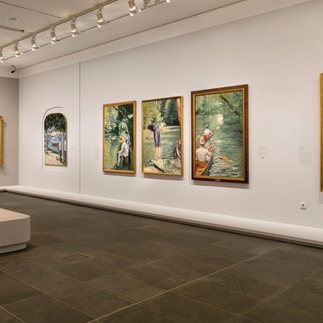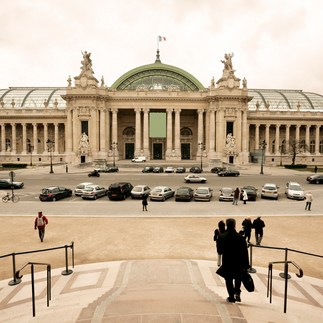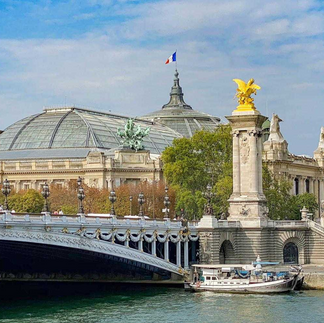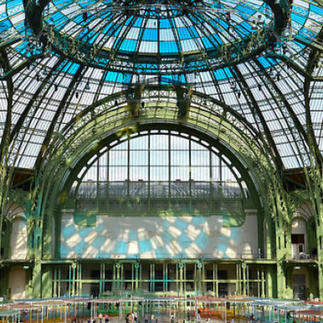The 10 most beautiful museums in Paris you absolutely need to visit during your trip in France
- Manon Dewitte

- Apr 19, 2023
- 9 min read
Updated: Sep 21, 2023
Paris is undoubtedly a city with a strong culture and a rich heritage. Among all the museums in Paris, it is hard to choose! Here is a selection of the 10 most beautiful museums in Paris to visit absolutely if you are traveling to the French capital.
1. The Louvre Museum
The Louvre Museum (Le Musée du Louvre) is the largest museum in Paris (+ over 60,000m2 of visitable surface) but it is also one of the largest and most famous museums in the world. The Louvre was founded in 1793, under the authority of the First Consul Napoleon Bonaparte.
It was originally the royal palace of the Capetian dynasty, which inhabited the building for over 500 years. The museum was opened to the public in 1793, after the French Revolution. It was designed by the architect Pierre Lescot and includes more than 35,000 art and antiquities objects. The Louvre is one of the most renowned and visited museums in the world, with over 10 million visitors per year.

The museum has been enlarged and refurbished several times over the centuries, notably by the renowned architect Ieoh Ming Pei. His famous glass pyramid, which stands in the Louvre courtyard, is a popular symbol of the era.
The Louvre is renowned for its exceptional collections, including Leonardo da Vinci's Mona Lisa, the Venus de Milo and the Victory of Samothrace. It also houses numerous works of European and Oriental art, as well as paintings, sculptures, works of art and antiques. The Louvre is also the venue for several exhibitions and cultural events, including shows, lectures and concerts. It is one of the most popular tourist destinations in the French capital.
Address: Quai du Louvre, 75001 Paris
Tickets: https://www.louvre.fr/en (It is recommended to buytickets in advance to avoid queuing at the ticket office on the day of your visit.)
2. Orsay Museum
The Orsay Museum (Le Musée d'Orsay) is a museum located on the banks of the Seine, in the 7th arrondissement of Paris. It is dedicated to the art and history of the period from 1848 to 1914. It is located in the former Orsay train station, a railway station built between 1898 and 1900. The station was closed in 1939 and was converted into a museum in 1986.
The museum was originally designed to house the collections of the Réunion des Musées Nationaux (RMN). It houses over 4,000 works of art, including paintings, sculptures, models, decorative works of art, and furniture. The works are mainly from the 19th century art movements, such as Impressionism, Post-Impressionism, Symbolism, Neo-Impressionism and Fauvism.The museum also hosts temporary exhibitions and lectures and presentations on art and history from the 19th century. It is also known for its large, ornate Art Nouveau-style clock in the main hall of the station, which has become one of the symbols of the museum.

The Musée d'Orsay is one of the major European art museums and receives approximately 3 million visitors each year. It is considered one of the most beautiful museums in the world and has been designated a UNESCO World Heritage Site.
Address: 1 Rue de la Légion d'Honneur, 75007 Paris, France
💡 There is a ticket bundle system with the Rodin Museum: you can buy a ticket for the Rodin Museum and the Orsay Museum to pay less! :) Perfect if you planned to visit both.
3. Musée de l'Orangerie
The Musée de l'Orangerie is a French museum located in the Jardin des Tuileries in Paris. It is dedicated to the works of Claude Monet and his successors, as well as a permanent collection of modern and contemporary art. The museum was founded in 1927 by Jean Walter and Paul Guillaume, two art collectors who were looking to create a museum dedicated to Monet's works. They purchased the Walter Collection, a collection of more than 800 works of Impressionism and modern art. Walter and Guillaume chose the Orangerie as the home of Monet's works. The Orangerie was an old orange greenhouse built in 1852 by the architect Jean-Charles Alphand. It was located at the end of the Jardin des Tuileries, near the Seine. In 1927, the two collectors donated the Walter Collection to the French state and the Musée de l'Orangerie was officially inaugurated on April 2, 1927.
Over the following years, the museum was expanded and many other collections were received. In 1931, it received the collection of Henri Matisse. In 1937, the museum opened its doors to works by Paul Cézanne, Georges Braque and Pablo Picasso.
It was closed during World War II, but reopened its doors in 1947 and was officially classified as a “National Museum” in 1960. In 1966, the Orangerie Museum received the bequest of Claude Monet’s legacy, which included eight of his Water Lilies series (Les Nymphéas) and over one hundred of his other works. These works are displayed in the Water Lilies Room and are considered one of the museum’s greatest attractions. The museum was renovated in 2006 and reopened to the public in 2008. It now houses over 5,000 works, including works by Matisse, Picasso, Renoir, Cézanne and Monet.
Address: Jardin des Tuileries, 75001 Paris, France
4. Picasso Museum
The Paris Picasso Museum, officially named "Musée National Picasso", was inaugurated in 1985. It is located in Le Marais, in the Hôtel Salé, a 17th century building. The museum is charged with conserving and promoting the work of one of the greatest artists of the twentieth century, Pablo Picasso. The museum houses more than 5000 works of art, including paintings, sculptures, drawings, engravings, and prints. It also features photographs, documents, and objects related to Picasso's life and work. The museum was created by the French Ministry of Culture, in partnership with the Centre Georges Pompidou. The museum's collection was created from the works of art given by Picasso himself and his family. In 1979, the artist and his family donated their entire collection of works to the French state, on condition that the museum be built in the Hôtel Salé.
The museum has been open to the public since 1985 and has welcomed more than 30 million visitors since then. It offers temporary exhibitions and educational programs to help visitors understand and appreciate Picasso's work. The museum is also active in the field of research and publication of books on the artist.

Address: 5 Rue de Thorigny, 75003 Paris, France
5. Rodin Museum
The Rodin Museum ("Musée Rodin") was founded in 1919 by the French sculptor Auguste Rodin. Located in the heart of Paris, the Rodin Museum enjoys an exceptional location just steps away from the Eiffel Tower and the Invalides. Comprised of an 18th century mansion and a sculpture garden of almost three hectares, the museum houses Rodin's sculptures.
The museum is a true sanctuary for Rodin's work and includes over 6,000 sculptures, 8,000 drawings, 8,000 prints and 1,500 letters. It also features works from the Impressionism and Barbizon school. The museum is divided into several sections, including the Marble Museum, the Room Museum, the Terra Cotta Museum and the Print Museum. There is also a garden with Rodin's sculptures, which were installed by the sculptor himself. The museum was fully renovated in 2016 and many exhibitions are held throughout the year. The museum is open to the public and offers guided tours and workshops for children. The museum is a must-see for art and sculpture lovers.

Address: 19 boulevard des Invalides, 75007 Paris
Tickets: https://www.musee-rodin.fr/en
💡 There is a ticket bundle system with the Rodin Museum: you can buy a ticket for the Rodin Museum and the Orsay Museum to pay less! :) Perfect if you planned to visit both.
6. Cluny Museum
Cluny Museum ("Musée de Cluny"), also known as the National Museum of the Middle Ages, is located in the 5th arrondissement of Paris. It was founded in 1843 by Alexandre du Sommerard, an art enthusiast who amassed a collection of medieval objects.The museum is located in a 15th-century townhouse, which was bought by the French government in 1843.
The museum's collection includes paintings, sculptures, engravings, works of art, tapestries, old books, religious objects and decorative objects. The objects are mainly medieval and date from the 5th to the 15th century. The museum houses the famous Bayeux Tapestry, a tapestry that dates back to the 11th century.

Many other pieces are exhibited in the museum, including wooden sculptures, medieval objects and illuminated manuscripts. The museum is open to the public and offers free guided tours. Visitors can also enjoy the auditorium, the mediation space and the temporary exhibitions. The museum also organizes special events such as conferences, concerts and workshops.
Address: 28 Rue du Sommerard, 75005 Paris
Tickets: https://www.musee-moyenage.fr/en/
7. Quai Branly Museum
The Quai Branly Museum ("Le Musée du Quai Branly") was created in 2006 by presidential decree, on the initiative of Jacques Chirac, then President of the French Republic. The museum is located on the banks of the Seine, near the Orsay Museum and the Louvre Museum. The aim of the museum is to promote the richness of the cultures and arts of non-Western civilizations, and to highlight their intercultural relations.It offers a permanent collection of over 300,000 objects, spread over more than 2,000 m2 of exhibition space.
The Quai Branly Museum showcases objects from the five continents, divided into four main areas: the art and cultures of the Americas, Africa, Asia and Oceania. The collection is complemented by audiovisual documents and temporary exhibitions.

Address: 37 Quai Jacques Chirac, 75007 Paris
8. Grand Palais
The Grand Palais houses one of the largest collections of paintings and sculptures in the world. It is located on the grand boulevard of the Champs-Élysées and is one of the main tourist attractions in the capital. The Grand Palais Museum was created in 1900 for the Universal Exhibition of Paris. It was designed by the architect Charles Girault, who also designed the Petit Palais (free museum), located right next to it.
The interior was designed by architect Henri Deglane. The Grand Palais Museum has been the site of several major exhibitions, including art exhibitions, scientific exhibitions, and historical exhibitions. In 1995, it was the site of the first traveling exhibition of the Louvre Museum abroad. Several big events and concerts have also been held at the Grand Palais Museum. The Grand Palais Museum also houses a rich collection of works of art, ranging from works of the old masters to those of modern artists. The collection includes paintings, sculptures, and objets d'art, as well as works by artists like Monet, Renoir, Matisse, and Picasso. The Grand Palais Museum is a popular cultural and entertainment venue in Paris. It welcomes thousands of visitors every year and is a must-see of the capital.
Note: The museum will be closed for renovations until the 2024 Olympic Games.
Address: 3 Av. du Général Eisenhower, 75008 Paris, France
9. Museum of Decorative Arts
The Museum of Decorative Arts (Musée des Arts Décoratifs) was founded in 1905 by the Society of Friends of Decorative Arts and opened its doors to the public in 1907. It has established itself as one of the most important museums dedicated to the history of decorative arts in Europe. The museum was designed by architect Charles Plumet and features a large collection of furniture, tapestries, textiles, jewelry, and works of art from the 17th, 18th and 19th centuries. The collections cover all artistic styles and movements, from Baroque to Art Nouveau, including the Rococo style and Empire style. The museum is also the home of the Centre de Recherche et de Documentation des Arts Décoratifs (CRDAD), which publishes in-depth studies on the history of decorative arts and organizes temporary exhibitions. The museum is located in the Louvre Palace and also offers guided tours, workshops, and activities for children. In addition, the museum has a bookstore and a café.

Address: 107 Rue de Rivoli, 75001 Paris
Tickets: https://madparis.fr/en
10. Hôtel des Invalides
The Hôtel des Invalides (or Musée de l'Armée) was founded in 1670 by Louis XIV to shelter and care for the veterans of his armies. It was built on the site of the old Invalides convent, dating from the 12th century, which had been transformed into a hospital for soldiers wounded during the Hundred Years War. The building was designed by the architect Jules Hardouin-Mansart and was completed in 1676. It was the headquarters of the Invalides congregation, which took care of the veterans of the royal army, and was the first military hospital built in France. In 1824, the Musée des Invalides was opened to the public and became a shrine for French veterans. Its installation was completed by museums dedicated to war, French military history and arms and armour. The museum was renovated in 1929 and was enlarged in 1977 and 1980. In 1993, it was declared a historic monument and was restored in 2001. The museum also houses the famous tombs of Napoleon I and the emperor of Austria, Franz Joseph. It is now one of the largest military museums in the world and attracts thousands of visitors each year.

Address: 129 r Grenelle, 75007 Paris
Do you know these museums? Do you have any other suggestions of museums to visit in Paris? 🇫🇷
Safe travels to Paris! Send us your photos and comments at bonjour@frenchcoffeebreak.com 💌
To go further
Do you want to improve your vocabulary and conversation before your trip to Paris? Sign up for our private lessons or join one of our group courses!
.png)



















Comments